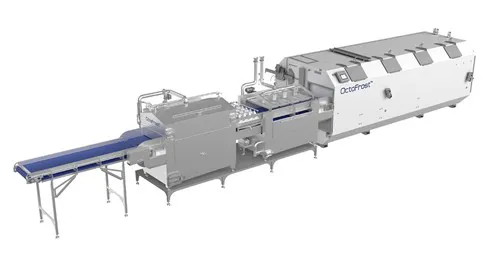For the past few years, green asparagus has been leaving its mark on the global market. Although not as popular in the United States, the other two asparagus, white and purple, are quite popular in the European and western Asian market. Demand for asparagus as a whole is steadily increasing.
Asparagus are difficult to process, due to their delicate body which can break easily. According to Ruben Larsson, Founder of OctoFrost, this is the major challenge to overcome when processing asparagus: “Whether fresh or frozen, asparagus is considered a high-value vegetable and as such any minor damage to its spear or tip would affect the selling price in a negative way. This goes double for peeled white asparagus, the most delicate and difficult one to process. During processing, all thin and long asparagus can get tangled together easily. So it’s no surprise breakage and tangling often happen when the asparagus are transferred between belts. It’s also preferable to have products come out in an order that is convenient for packing, as it has been loaded on the first belt. We’ve put out an asparagus line on the market that solves these issues”

No manual handling required for horizontal asparagus processing line
The entire OctoFrost™ asparagus processing line consists of the IF blancher, IF chiller, and IQF tunnel freezer. According to Larsson, it’s recommended to pre-cool fresh asparagus in a hydro cooler at +1C before entering it in the Freezer. “As the complete line is horizontal, asparagus lay statically during the entire processing time. The asparagus leaves the Freezer as it was put on the blancher belt. This means there is no extra manpower required, which is better in terms of hygiene. Since there is no drop during the entire process, the risk of damage to the tips of the asparagus is eliminated,” Larsson explains. “Other, more traditional asparagus lines come in multiple levels, that can not only result in broken tips, but also leaves the produce unsorted as it leaves the belt. This means additional workforce is required to sort the asparagus as the outfeed of these IQF freezers.”
Best practices
The best result can be reached when operating the processing line in the optimal way, says Larsson. “Asparagus should be manually loaded lengthwise before entering the blancher. Loading can be done with a rather high bed depth, to achieve capacity; this requires an efficient penetration of blanching water at high volumes to reach a uniform blanching and chilling.”
Using the asparagus line is unique compared to IQF Freezing other vegetables: “Unlike other vegetables, the air circulating inside the IQF Freezer needs to be set in a way that the product isn’t moving at all while freezing. In the Freezer, forced and controlled airflow is fast and efficient without creating "rat holes" that make products disordered. Therefore, a precise scalping and precooling before the freezing process in combination with the IQF with fully controlled air, will result higher capacity, lower total processing cost, and better bite and color of the asparagus.” Larsson concludes.
For more information:
OctoFrost Group
Email: sales@octofrost.com
www.octofrost.com
